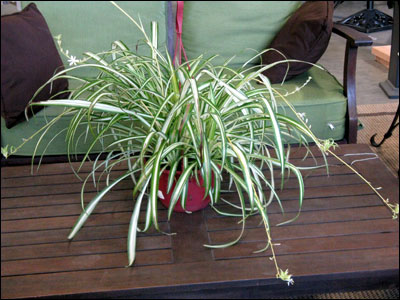Spider Plant
The UF/IFAS Assessment of Non-Native Plants in Florida’s Natural Area’s recently predicted spider plant to become invasive in Florida and is no longer recommended by UF/IFAS Extension.

An incredibly popular houseplant, the spider plant is easy to grow and requires very little attention. Its common name comes from the “spidery” look of the baby plants it grows rapidly.
The spider plant’s trailing growth makes it perfect for hanging baskets. And it’s not only an attractive addition to your home; like many indoor plants, spider plant removes airborne pollutants from the air.
Characteristics
The spider plant (Chlorophytum comosum) forms mounds of narrow leaves. While spider plants with all green leaves can be found, these are the rarest variety. Most commonly, spider plants are found with a white or yellow stripe down the center of the leaves. The ‘Vittatum’ selection is the most common with a white stripe. Spider plant spreads by growing long shoots that develop pre-rooted plantlets at their tips and has clusters of small white flowers.
Spider plant’s cascading leaves form a graceful skirt in hanging baskets, but can also work great as a groundcover in shady spots in the South Florida landscape. It prefers shaded areas and can tolerate a wide range of soil conditions, but should be protected from frost.
Planting and Care
This tough plant thrives on neglect, making it an ideal houseplant. Spider plant prefers bright to moderate indirect light year round and average temperatures. Temperatures below 55°F are too cool for spider plants while those above 80° are too warm, making this a great indoor plant.
This plant is particularly sensitive to fluoridated water; if your water is treated with fluoride, watering with rainwater or distilled water is best for the health of your plant. When watering your spider plant remember that the upper inch of soil should be allowed to dry out briefly between waterings.
A potted spider plant will thrive with repotting once a year while the plant is young and then every other year once it matures. To propagate your spider plant, simply remove and pot the plantlets.
